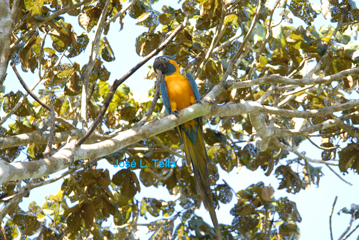Seed dispersal is one of the most studied plant-animal mutualisms. It has been proposed that the dispersal of many large-seeded plants from Neotropical forests was primarily conducted by extinct megafauna, and currently by livestock. Parrots can transport large fruits using their beaks, but have been overlooked the seed dispersers. This study demonstrates that three macaws (Ara ararauna, A. glaucogularis and A. severus) are the main dispersants of the large-seeded motacú palm Attalea princeps, which is the biomass-dominant tree in the Bolivian Amazonian savannas. Macaws dispersed fruits at high rates (75-100% of fruits) to distant (up to 1200 m) perching trees, where they consumed the pulp and discarded entire seeds, contributing to forest regeneration and connectivity between distant forests islands. The spatial distribution of immature palms was positively associated with the proximity to macaws' perching trees and negatively to the proximity to cattle paths. The disperser role of livestock, presumably the substitute for extinct megafauna, had little effect due to soil compaction, trampling and herbivory. These results underscore the importance of macaws as legitimate, primary dispersers of large-seeded plants at long distances and, specifically, their key role in shaping the landscape structure and functioning of this Amazonian biome. informacion[at]ebd.csic.es: Baños-Villalba et al (2017) Seed dispersal by macaws shapes the landscape of an Amazonian ecosystem. Sci Rep doi:10.1038/s41598-017-07697-5
https://www.nature.com/articles/s41598-017-07697-5

 Las altas temperaturas están provocando que las lagunas y las marismas de Doñana pierdan agua rápidamente
Las altas temperaturas están provocando que las lagunas y las marismas de Doñana pierdan agua rápidamente




